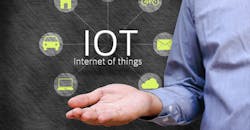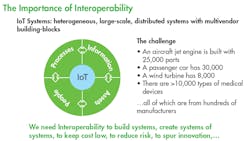Q&A: Smart Objects Meet IoT Demands for Interoperability
Download this article in PDF format.
The IPSO Alliance is “focused on enabling IoT devices to communicate, understand, and trust each other with global interoperability based on open standards.” Members take an IP-based approach to Internet of Things (IoT) connectivity.
I recently talked with Christian Légaré, President and Chairman of the IPSO Alliance, about its charter and the current state of affairs when it comes to IoT connectivity.
Christian Légaré is President and Chairman of the IPSO Alliance, and Director of the IoT OS Platform at Silicon Labs.
What is interoperability? Why is it important for IoT?
Interoperability is defined at many different software and networking levels. A good way to understand interoperability is to view it as the North American construction standard. For example, all doors have a standard opening of 32 inches. When you buy a white good in North America, you know you’ll be able to get it through the door.
Sometimes the term “interoperability” can be interchanged with “standards,” but it doesn’t have to be a certifiable standard such as UL or similar; sometimes standards can be de facto. In either case, there are clear and tangible benefits to interoperability and standards. However, especially with software and the open-source community, standards are sometimes perceived as obstacles to innovation. The reality for smart devices, however, is that we need interoperability and some level of common definitions. Interoperability is the use of these common definitions so that products can work together.
First, let’s look at networking. Specifically, the 40-year-old OSI model that defined the layers in networking, the physical layer (copper or fiber), the layer above (Ethernet), and then the internet protocol. All of these networking layers were defined to be interoperable with each other. Next, let’s look at the IoT. Interoperability still needs to happen at these levels, but also above it, for the transport layers that are above TCP and UDP.
If machines on both sides are using HTTP, then they need to use it the same way; and the same is true for CoAP and MQTT. Next, you have to look at what’s being transported in the payload, i.e., the message types. Within the IPSO Alliance, we refer to this as semantics and make recommendations on how to represent it. Defining the data model for the data layer has been a main focus for the Alliance. Fundamentally, regardless of which layer something is in, the goal is to make sure that A and B can always understand each other.
Interoperability is important for the IoT because of cost. If everything is developed in isolation, “things” will work, certainly; but, they’ll take longer to develop and likely will use proprietary data and models that simply aren’t usable by others. It’s similar to a ball team with a lot of individual talents: If they can’t play as a team, they won’t win. So, when you put all of the IoT devices and data together, then the value of the system—or even system of systems—will grow. There was a study from McKinsey that showed the value of IoT grows by 40% when systems can interoperate.
Buildings offer a clear example. They have all kinds of systems—power, water, lighting, HVAC, etc. These systems can all be operated separately, but you start to achieve economies of scale if they can interoperate. When you start to put the data together, and in relation to the other data points, then the value grows drastically.
At what technical level does interoperability work?
Interoperability happens at multiple levels, many of which have been resolved in the 40 years since the creation of the internet. The “p family” of protocols (UDP, HTTP, etc.) at the network layer demonstrate this. Now we need to define interoperability at newer layers that weren’t present before: semantic, data, and services. Blockchain is another example; i.e., how can machines establish contracts between machines?
The need for interoperability is compelling when looking at part counts and different manufacturers involved.
What is IPSO’s role in interoperability?
IPSO’s stated purpose has always been to explore, evaluate, and recommend best practices related to the use of IP in the IoT. We are not a standards definition organization; however, it turns out that our smart-object guidelines are in fact becoming a de facto standard.
We set out to define a model whereby semantic data could be easily conveyed and understood, publishing a limited set of definitions that has been met with broad interest. The Smart Object Guidelines have turned out to be ideal for LwM2M [LightweightM2M] applications, for example, which has led to a significant expansion of our object definitions. Now the question is how can we work with our semantics and data models and find the right framework to standardize them, given their broad adoption?
How do IPSO Smart Objects interact with existing standards?
IPSO uses existing standards. Our work to determine best practices and establish guidelines is based on standards; e.g., what to use, where, why, and when. We’re actively working to establish liaisons with organizations like OMA, OCF, IETF, and Thread so that we know what they’re working on and their next steps. That way, we can advise as to whether we think their approach makes sense. This is very much in line with our working group model, where we offer guidelines for existing standards or offer our opinion on those under development and discussion.
Can IPSO Smart Objects be the semantic interoperability layer for IoT?
Absolutely, and for one simple reason. When we defined the Smart Object Guidelines, the entire premise was they would be vertical-market-independent. They weren’t defined for industrial, or medical, or consumer; they are generic and light and simple. We feel this is why they were adopted so quickly.
So, while we’re confident our Smart Objects can be the interoperability data model layer for the IoT, we also recognize they need an organizational structure around them and additional definitions to support their evolution.
What other work is the IPSO Alliance doing, and how does that relate to interoperability?
The Alliance is also heavily invested in work on security, identity, and privacy, which we believe is the next frontier for IoT. We won’t say that our semantic data work is “done,” but we’ve made significant progress.
We now need to focus on device management, which builds on our earlier work. Device management is how you recognize and authorize an IoT device; how you make sure something is a valid device that you can control; how you turn on services or authorize certain features. If you push a firmware upgrade, how do you ensure its validity or success? How can a device report software, hardware, or memory issues?
This next frontier is clearly based on all of the work we’ve done already in network, protocol, and data interoperability. Now we need to establish interoperability in how devices are managed. We can go back to the building example—if heating, light, and water systems can be similarly managed, then you can have a single management system, which again gets back to economies of scale.
In the big telecom era of the ’90s, all of the equipment was made by different companies using different management systems, and operators struggled to build a network operating center, as they lacked visibility into what was happening. As a result, standards started to be defined so that equipment could speak the same language and be managed centrally. The IoT is facing the same issue now.
Many platforms have different hardware and software requirements, so how—as a user or system operator—can you manage all of the devices (think trucks, planes, vehicles, equipment)? A single system is key. And, of course, once we can rally around a single system, it must be secure.
About the Author
William G. Wong
Senior Content Director - Electronic Design and Microwaves & RF
I am Editor of Electronic Design focusing on embedded, software, and systems. As Senior Content Director, I also manage Microwaves & RF and I work with a great team of editors to provide engineers, programmers, developers and technical managers with interesting and useful articles and videos on a regular basis. Check out our free newsletters to see the latest content.
You can send press releases for new products for possible coverage on the website. I am also interested in receiving contributed articles for publishing on our website. Use our template and send to me along with a signed release form.
Check out my blog, AltEmbedded on Electronic Design, as well as his latest articles on this site that are listed below.
You can visit my social media via these links:
- AltEmbedded on Electronic Design
- Bill Wong on Facebook
- @AltEmbedded on Twitter
- Bill Wong on LinkedIn
I earned a Bachelor of Electrical Engineering at the Georgia Institute of Technology and a Masters in Computer Science from Rutgers University. I still do a bit of programming using everything from C and C++ to Rust and Ada/SPARK. I do a bit of PHP programming for Drupal websites. I have posted a few Drupal modules.
I still get a hand on software and electronic hardware. Some of this can be found on our Kit Close-Up video series. You can also see me on many of our TechXchange Talk videos. I am interested in a range of projects from robotics to artificial intelligence.




